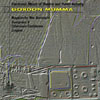 I have had a long time love affair with the first generation of electronic music composers. Perhaps it is akin to the way I used to romanticize the early explorers of America when I was a young boy, only now I geek out over those who pioneered circuit boards. Gordon Mumma was such a pioneer, exploring the cybersonic world with his own home built audio devices. His music partook in the spirit of joyful discovery that was evident throughout those early years, while also being physically visceral.
I have had a long time love affair with the first generation of electronic music composers. Perhaps it is akin to the way I used to romanticize the early explorers of America when I was a young boy, only now I geek out over those who pioneered circuit boards. Gordon Mumma was such a pioneer, exploring the cybersonic world with his own home built audio devices. His music partook in the spirit of joyful discovery that was evident throughout those early years, while also being physically visceral.
“Megaton for Wm. Burroughs” opens with a searing blast, a long overdriven tone that gradually builds in intensity, the hot white heat of a nuclear decimation, than fades like smoke from a mushroom cloud. The sounds of laser ray guns emerge from the ruins, a chirping crossfire of blips and squeaks. Strangled strings and other oddments are played ONCE group, whose members included Robert Ashley, as accompaniment to Mumma’s tape composition. As the piece progresses the bleeps are elongated into psychoactive slurs, trailing electric glissandos, the white fuzz of a burned out television set. For awhile no clear reception is present, but then voices come in: different military men giving orders and reports in each speaker, along with the rat-a-tat-tat of machine guns. The song ends with the steady hi-hat taps of simple jazz percussion. I can see why this song was written for William Burroughs: it is very evocative of the apocalyptic interzone he inhabited.
Three out of the four songs collected here were used originally as accompaniment for actors in various stage productions. While all were able to stand on their own, apart from attendant theatrics, sometimes it seemed that I would have been able to get more out of them if I had been present to see what was going on. “Conspiracy 8,” co-written with Stephen Smoliar, is a case in point. It consists mainly of atonal feedback in varying degrees of amplitude, strange rustlings, and the occasional ding of a clerk bell. Laughter from the audience is heard at various points throughout, though I don’t hear in the music what it is that might be funny. It is still enjoyable, but since I can’t see what is going on, I won’t be joining with the laughter. “Cirqualz” by contrast, is far funnier. Starting with the opening bars from Beethoven’s Third Symphony, and a voice that says “those two whiplashes of sound that shattered the elegant formality o the eighteenth century”, before moving into a series of brief, but disarranged, sections of circus, marching, and romantic music. Sounds of fireworks filter in, exploding above the symphonic fanfare that is now slightly drowned out by synthesizer gurgles. It all ends rather abruptly with a screech of brakes and a cinematic car crash.
“Cybersonic Cantilevers” is a gem, and for me the highlight of the album. For this piece Mumma invited public participants to join him in supplying sounds of their own choice into microphones and cassette decks, which he then processed in real time with his cybersonic equipment during a day long sound installation. The 19 minutes here are a condensation of the last hour of the performance, assembled from what he was able to capture with a portable recorder. It begins with a hyper rock and roll snippets juxtaposed with the gravelly voices of detective radio dramas. The stops, starts, and fast switches between these sound sources, all accompanied by weird effects, creates a brilliant off-kilter rhythm, before dissolving into a beautifully mesmerizing drone for the second half of the song.
The works presented here span the years from 1964 to 1980. This is an important document from an important American composer, and the perfect addition to the library of anyone collecting early electronic music.
samples:
Read More

